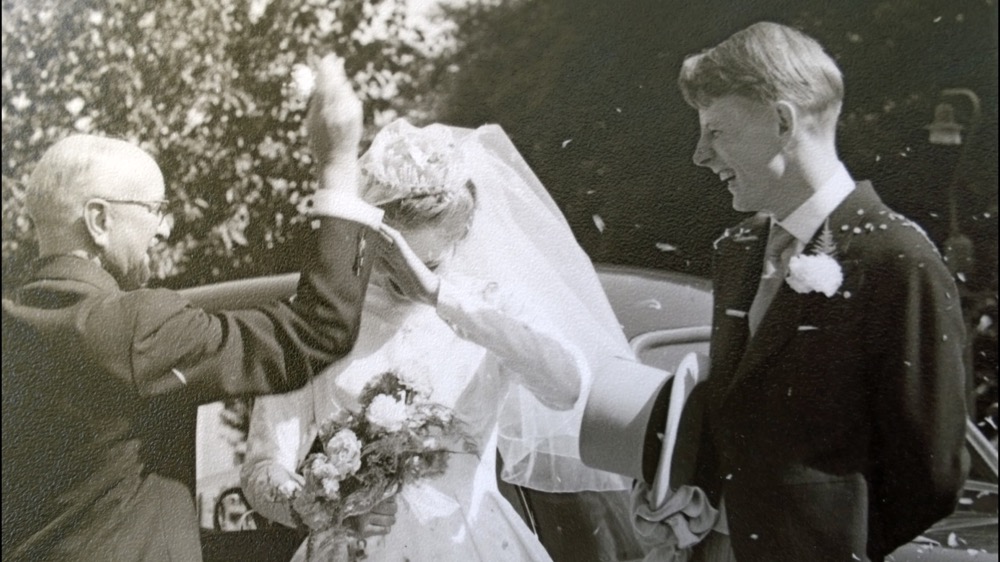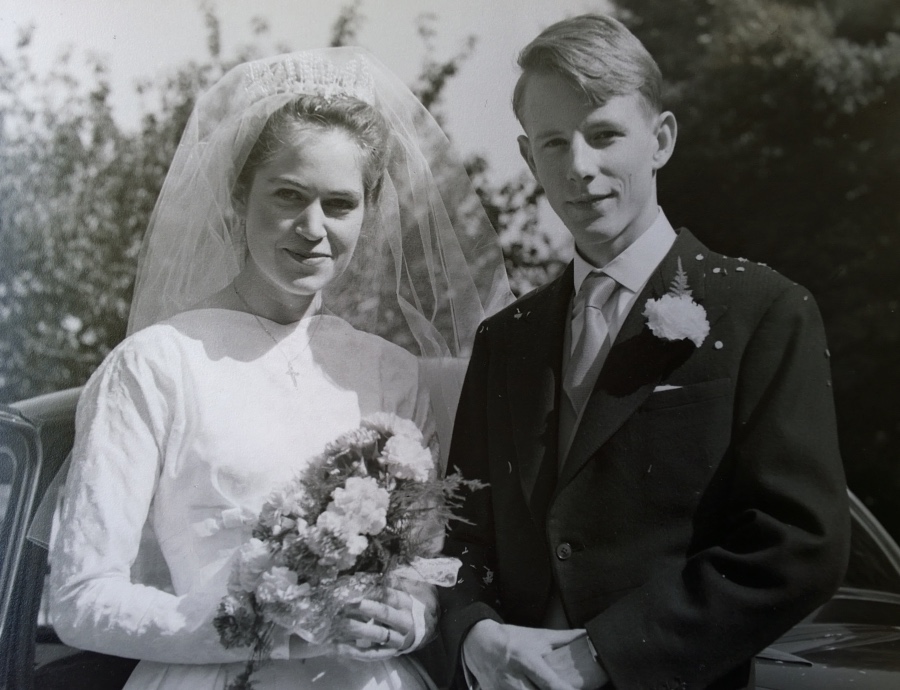If there's a resurgence in doing this, by the way, it's because Google recently released and has started to promote a utility called 'Photo Scan'. Actually quite clever, this leads a user through taking four photos of the same print from slightly different viewpoints and then the software auto-magically combines these to good effect.
Of you could just use a phone with a decent camera in the first place, along with a little expertise. Which is where this feature comes in.

From the late 1950's, an action snap of my parents' wedding, captured here on my Lumia 1020. Note the grain of the physical print, but still a candid moment!
The scenario then. You have an old photo, often in an album, and you're struck by how many memories it brings back. Not just an old snap, this is worthy of a little effort by you in order to try and make it 'digital' and thus trivially copied and backed up. Here's what to do (and I've done it multiple times, so I'm speaking from experience):
1. Isolate the photo, if needed
If in a physical photo album then take it out from whatever corner or plastic layers are holding it in place. Don't just be lazy and try to snap it in situ.
2. Place the photo in a flat, well lit place, ideally daylight
Suitable places include a carpet next to french windows or a wide window ledge. Try to find the side of your house that's brightest, depending on the season and where the sun is in the sky. However, avoid direct sunlight, since that will introduce contrast and colour balance issues. So if the sun is streaming in, find a flat spot just out of direct sunlight. If you're forced into doing this at night, try a kitchen or office with fluorescent (strip) light, since this is whiter and less 'yellow'.
3. Set up your phone
Take your Lumia 950 XL or 950 (ideally, though lesser phone cameras may also be sufficient) and head into Camera as usual. Set it at a lower/oversampled resolution if applicable, since the actual printed resolution of the print will be a lot lower than that of your camera sensor, so it makes no sense to shoot in a high resolution mode. On the 950 range you then also get extra purity per pixel etc.
4. Positioning
With the photo flat and well lit, position your phone camera in the right aspect ratio (portrait/landscape) and with the centre of the camera over the centre of the photo. Make sure to get the whole snap in frame and double-check that the photo is properly focussed. You don't need to try and get super-close, it's OK to have some carpet or window ledge either side of the photo - you're going to be cropping the photo anyway and if you get too close then extra optical 'macro' distortion may be an issue.
5. Avoid glare and reflections
Now, this is vitally important - as you take the photo, watch out for reflections and glare - these are often an issue with modern 'gloss' prints. If glare is an issue then you may find that changing your shooting angle, even by a couple of degrees, will fix things. Or perhaps move the print slightly as well.
6. Crop
With the print now snapped, wait a few seconds for any post-processing in Windows 10 Camera and then tap on the 'Edit' tool. Crop the photo down as needed (usually to its original boundaries). Don't worry about the drop in resolution - whatever you do, the limiting factor on quality will be the original (e.g. 6" x 4") print, not the resolution of your phone-shot photo.
7. Enhance
Once cropped, you'll usually find that extra contrast and saturation will help, especially if the original print had perhaps faded. If on a Lumia then you may well have Lumia Creative Studio built in and this is ideal to tweak an image, keeping the resolution. If on a non-Lumia, then a utility like Tapershot can help.

Another example from that wedding, here for a more formal shot. Given that the original photo was taken almost 60 years ago on goodness knows what camera hardware, this came out pretty well.
The process can take a couple of minutes per print if you're taking care, which is why many people don't bother if they have dozens of prints and farm the process out to a specialist shop. But if its just a few photos and you're encountering them on-the-fly (for example, at a relative's house) then being able to press your smartphone into service as a makeshift photo lab is a very useful option.
PS. You don't have to go back as far, many of us have decent colour prints from the 1980s and 1990s, of course. Or perhaps you can give examples, snapped on Windows Phones, from much earlier? Anyone got a good example of a Lumia-shot print pre-World War 2?
